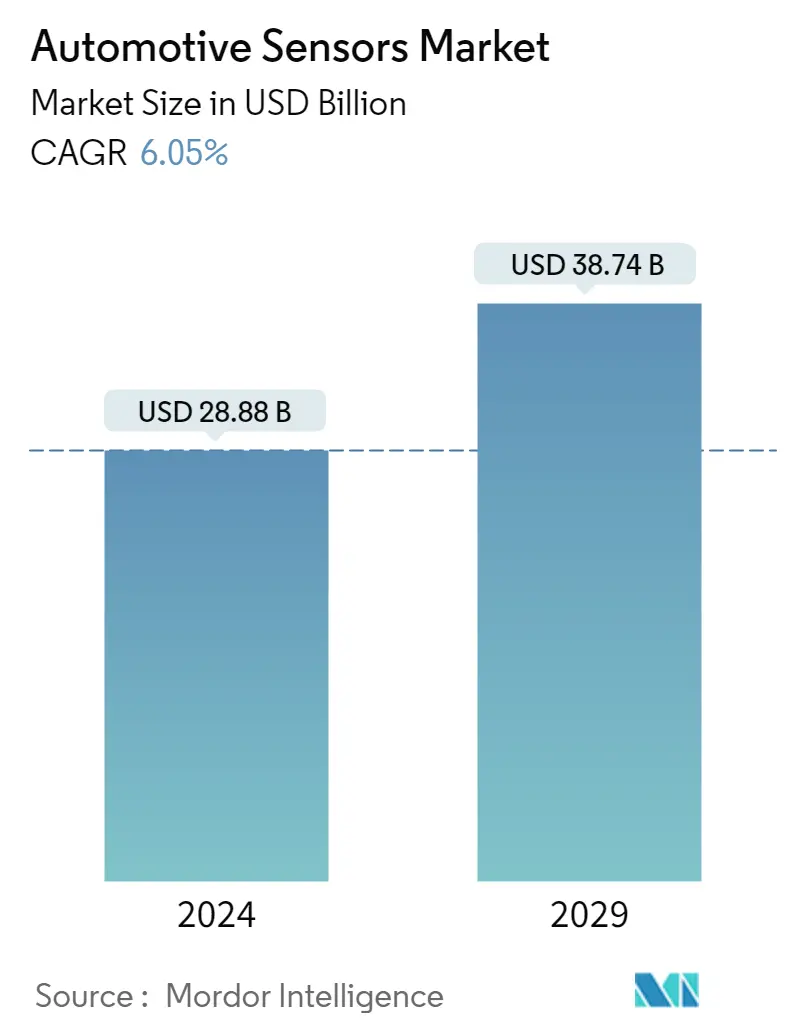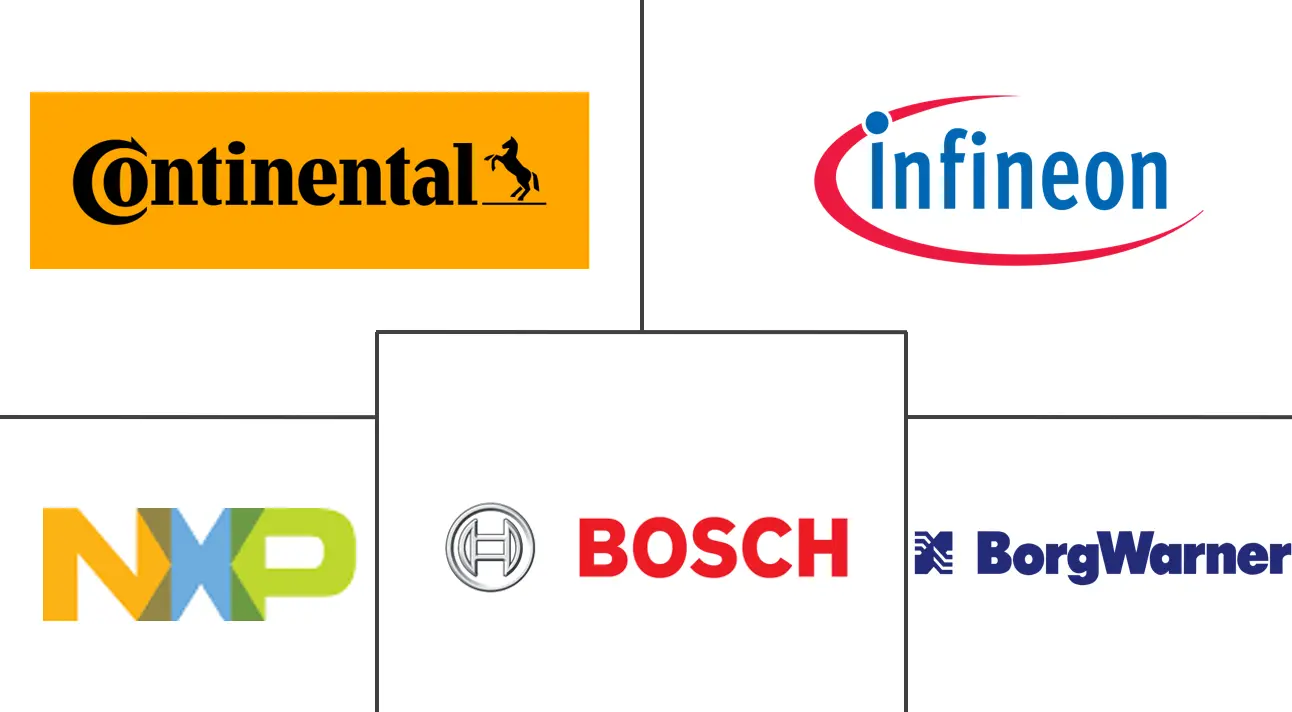Market Size of Automotive Sensors Industry

| Study Period | 2019 - 2029 |
| Market Size (2024) | USD 28.88 Billion |
| Market Size (2029) | USD 38.74 Billion |
| CAGR (2024 - 2029) | 6.05 % |
| Fastest Growing Market | Asia Pacific |
| Largest Market | North America |
Major Players
*Disclaimer: Major Players sorted in no particular order |
Automotive Sensors Market Analysis
The Automotive Sensors Market size is estimated at USD 28.88 billion in 2024, and is expected to reach USD 38.74 billion by 2029, growing at a CAGR of 6.05% during the forecast period (2024-2029).
The COVID-19 pandemic had a significant impact on the automotive industry, including the automotive sensors market. During the pandemic, many automotive manufacturing plants were shut down, which led to a reduction in the production of vehicles and consequently, a decrease in demand for automotive sensors. Additionally, the disruption in the global supply chain due to the pandemic resulted in a shortage of raw materials and components, which further affected the production of automotive sensors.
However, the market for automotive sensors is now recovering, and the demand for sensors is expected to increase as the automotive industry recovers. The pandemic has also accelerated the adoption of advanced driver assistance systems (ADAS) and autonomous vehicles, which rely heavily on automotive sensors. This is expected to drive the growth of the automotive sensors market in the coming years, as manufacturers increasingly incorporate these features into their vehicles.Over the long term, the automotive sensors market is expected to grow driven by the factors such as increasing demand for advanced driver assistance systems (ADAS) and autonomous vehicles.
Automotive sensors are components of a vehicle that are designed to detect, transmit, analyze, record, and display vehicle performance information from the vehicle's internal and external environments. The demand for automotive sensors is expected to rise significantly during the forecast period, owing to the growing popularity of vehicle automation and the growing demand for connected cars around the world.
Additionally, customers are also becoming more aware of new safety systems and technology, and they are increasingly selecting vehicles with improved safety features. Automotive manufacturers have been forced to equip their vehicles with features such as driver assistance systems, as passenger safety concerns have grown. Such factors are pushing the demand for sensors.
The use of several automobile sensors such as electric power steering (EPS) helps to provide the driver with extra safety benefits. Furthermore, the adoption of stringent fuel efficiency standards by government and international safety measures, are seen as major drivers for the expansion and development of advanced systems (such as EPS), which make extensive use of sensors.
The demand for electronic sensors for these position sensors in the automotive industry is expanding as a result of the increasing and continuous developments and breakthroughs in technology. As a result, the automotive sensor market is expected to increase significantly throughout the forecast period.
The automotive industry's recent shift in attention to technical developments such as electrification and autonomous driving has raised the demand for sensors. At the same time, the manufacturers' preference for integrating position sensors into vehicles suggests that the market will continue to grow.
Autonomous vehicles (especially level 4 and level 5) that feature self-driving systems generally process huge amounts of data to give feedback to the automotive system to drive smoothly clearing obstacles or performing turning maneuvers as per traffic signs. Due to this, it is expected that a greater number of sensors need to be incorporated into these types of vehicles, which is expected to drive the market for this segment.
Automotive Sensors Industry Segmentation
Automotive sensors are used to gather information about the vehicle's surroundings, such as its speed, location, and environment, and then send this information to the vehicle's onboard computer system to make decisions.
The Automotive Sensors Market is Segmented by Type (Temperature Sensors, Pressure Sensors, Speed Sensors, Level/Position Sensors, Magnetic Sensors, Gas Sensors, and Inertial Sensors), Application (Powertrain, Body Electronics, Vehicle Security Systems, and Telematics), Vehicle Type (Passenger Cars and Commercial Vehicles), and By Geography (North America, Europe, Asia-Pacific, and Rest of World). The report covers the market size in value (USD billion) for all the above segments.
| Type | |
| Temperature Sensors | |
| Pressure Sensors | |
| Speed Sensors | |
| Level/Position Sensors | |
| Magnetic Sensors | |
| Gas Sensors | |
| Inertial Sensors |
| Application | |
| Powertrain | |
| Body Electronics | |
| Vehicle Security Systems | |
| Telematics |
| Vehicle Type | |
| Passenger Cars | |
| Commercial Vehicles |
| Geography | |||||||
| |||||||
| |||||||
| |||||||
|
Automotive Sensors Market Size Summary
The automotive sensors market is poised for significant growth over the forecast period, driven by the increasing demand for advanced driver assistance systems (ADAS) and the rise of autonomous vehicles. These sensors play a crucial role in enhancing vehicle safety and performance by detecting, transmitting, and analyzing data from both internal and external environments. The market is recovering from the disruptions caused by the COVID-19 pandemic, which had led to a temporary decline in demand due to reduced vehicle production and supply chain challenges. However, the accelerated adoption of ADAS and autonomous driving technologies is expected to propel the market forward, as manufacturers integrate more sensors to meet consumer safety expectations and regulatory requirements.
The Asia-Pacific region is a key player in the automotive sensors market, with its rapid economic growth, increasing vehicle sales, and strong presence of manufacturing industries in countries like China, India, and Japan. The region's favorable regulatory environment and government initiatives to promote electric vehicles and advanced safety features further bolster market expansion. As consumers in developing economies become more safety-conscious, there is a growing trend to incorporate sensors into low-cost vehicles, driving demand. Major industry players, including Continental AG, Robert Bosch GmbH, and NXP Semiconductors, are actively engaging in product innovations and collaborations to enhance their market offerings, ensuring a positive outlook for the automotive sensors market in the coming years.
Automotive Sensors Market Size - Table of Contents
-
1. MARKET DYNAMICS
-
1.1 Market Drivers
-
1.2 Market Restraints
-
1.3 Industry Attractiveness - Porter's Five Forces Analysis
-
1.3.1 Threat of New Entrants
-
1.3.2 Bargaining Power of Buyers/Consumers
-
1.3.3 Bargaining Power of Suppliers
-
1.3.4 Threat of Substitute Products
-
1.3.5 Intensity of Competitive Rivalry
-
-
-
2. MARKET SEGMENTATION
-
2.1 Type
-
2.1.1 Temperature Sensors
-
2.1.2 Pressure Sensors
-
2.1.3 Speed Sensors
-
2.1.4 Level/Position Sensors
-
2.1.5 Magnetic Sensors
-
2.1.6 Gas Sensors
-
2.1.7 Inertial Sensors
-
-
2.2 Application
-
2.2.1 Powertrain
-
2.2.2 Body Electronics
-
2.2.3 Vehicle Security Systems
-
2.2.4 Telematics
-
-
2.3 Vehicle Type
-
2.3.1 Passenger Cars
-
2.3.2 Commercial Vehicles
-
-
2.4 Geography
-
2.4.1 North America
-
2.4.1.1 United States
-
2.4.1.2 Canada
-
2.4.1.3 Mexico
-
2.4.1.4 Rest of North America
-
-
2.4.2 Asia-Pacific
-
2.4.2.1 China
-
2.4.2.2 Japan
-
2.4.2.3 India
-
2.4.2.4 South Korea
-
2.4.2.5 Rest of Asia-Pacific
-
-
2.4.3 Europe
-
2.4.3.1 Germany
-
2.4.3.2 United Kingdom
-
2.4.3.3 France
-
2.4.3.4 Rest of Europe
-
-
2.4.4 Rest of the World
-
2.4.4.1 Brazil
-
2.4.4.2 United Arab Emirates
-
2.4.4.3 Other Countries
-
-
-
Automotive Sensors Market Size FAQs
How big is the Automotive Sensors Market?
The Automotive Sensors Market size is expected to reach USD 28.88 billion in 2024 and grow at a CAGR of 6.05% to reach USD 38.74 billion by 2029.
What is the current Automotive Sensors Market size?
In 2024, the Automotive Sensors Market size is expected to reach USD 28.88 billion.

